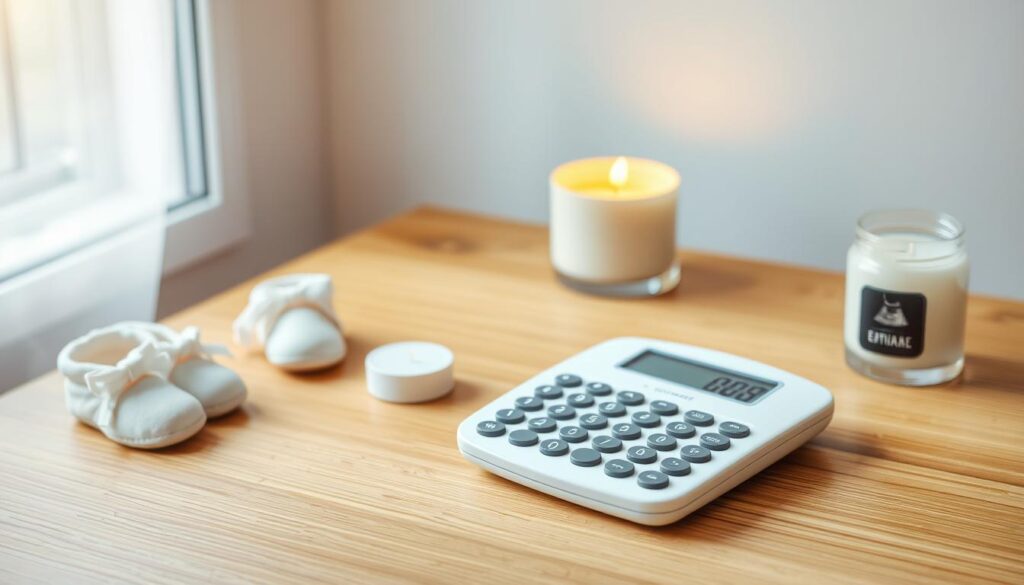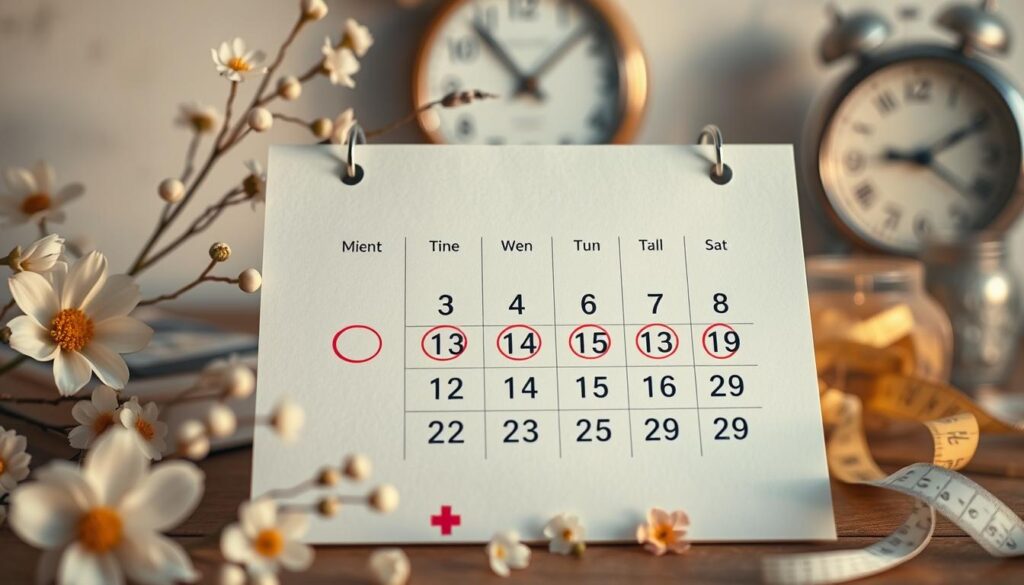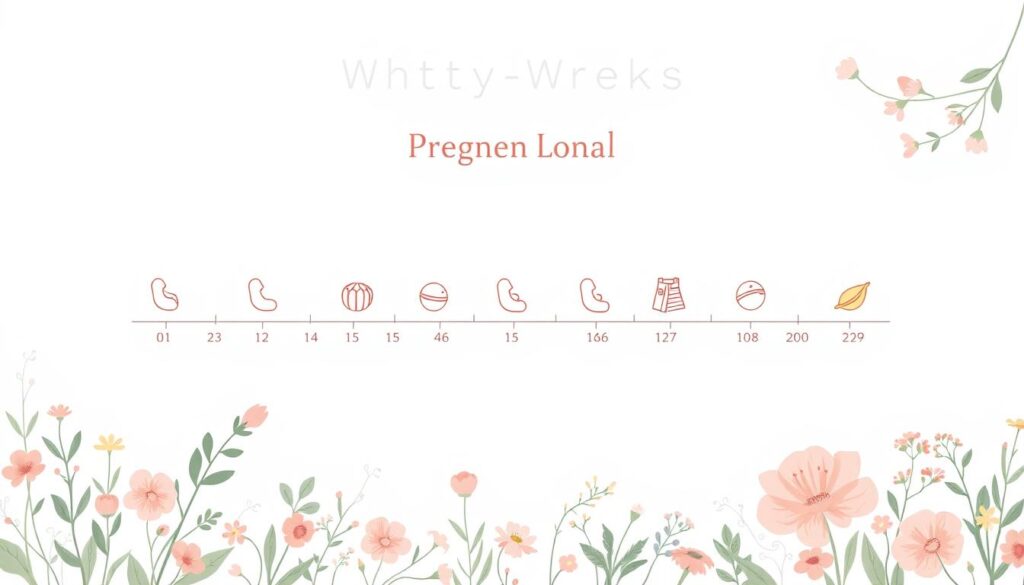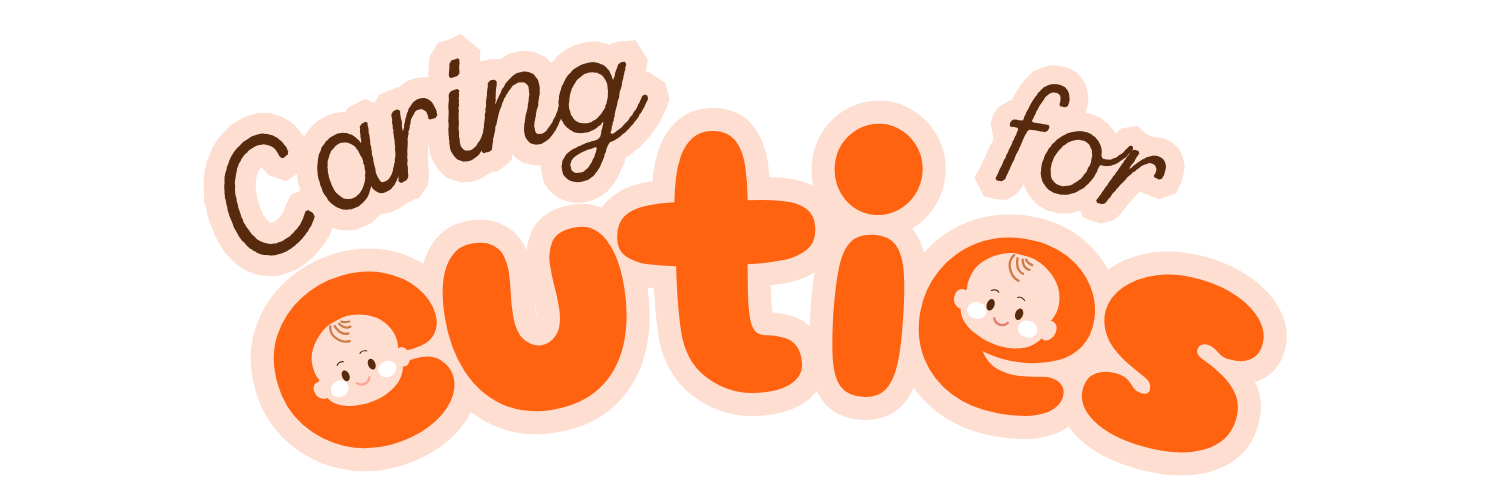Are you excited for your baby’s arrival? Pregnancy is both thrilling and a bit scary. But, a reliable pregnancy calculator can help you find your due date. This lets you plan for your baby’s arrival.
Pregnancy calculators are great tools. They give you a clear timeline of your pregnancy. This helps you prepare for your baby and get the right medical care.

Ever wondered how these calculators work? And how accurate they are? Knowing the science behind them can help you use them better. It also lets you talk more meaningfully with your healthcare provider about your pregnancy.
In this article, we’ll dive into the world of pregnancy calculators. We’ll show you how to find your due date with confidence.
Key Takeaways
- Pregnancy calculators are essential tools for expectant mothers to determine their due date and plan for their baby’s arrival.
- These calculators use a variety of methods to estimate the due date, including the last menstrual period (LMP) and other factors.
- Understanding the science behind due date calculations can help you make the most of pregnancy calculators and have more informed discussions with your healthcare provider.
- While pregnancy calculators are generally accurate, there are various factors that can affect the due date estimation, such as cycle length variations and medical conditions.
- Tracking your pregnancy journey and combining multiple methods can lead to more precise due date predictions.
Understanding Due Date Calculations and Their Importance
Figuring out when a baby will arrive is key in prenatal care. The pregnancy test calculator, edd calculator, and estimated due date calculator are very important. They help doctors and soon-to-be parents get ready for the baby’s arrival.
The due date, or estimated date of delivery (EDD), is usually figured out from the mom’s last period. This helps doctors know when the baby is ready to be born. Knowing the due date helps with planning and keeping an eye on the pregnancy. It makes sure the mom and baby get the best care.
| Importance of Due Date Calculations | Benefits |
|---|---|
| Prenatal Care Planning | Scheduling medical appointments, prenatal tests, and interventions at the appropriate times |
| Fetal Development Monitoring | Tracking the baby’s growth and identifying any potential issues or complications |
| Delivery Preparation | Coordinating with the healthcare team and making necessary arrangements for the birth |
| Expectant Parent Readiness | Allowing parents to mentally and physically prepare for the arrival of their child |
Getting the due date right is very important for the health of mom and baby. By understanding how these calculations work, expectant parents can make better choices. This makes their pregnancy journey more positive and informed.
How to Use a Pregnancy Calculator
Using a pregnancy calculator to find your due date is easy. These tools help you figure out when you’ll have your baby. You just need to know your last menstrual period (LMP) or other important details. Let’s look at how to use a pregnancy calculator right.
Entering Your Last Menstrual Period (LMP)
The first thing to do is enter your last menstrual period date. This is the key to figuring out when you got pregnant. It helps the calculator know when your baby will be born.
Adjusting for Irregular Cycles
If your periods are not regular, you might need to tell the calculator more. Just give it details about your cycle length and timing. This way, the calculator can give you a better guess, even if your cycles are not the usual 28 days.
Understanding the Results
After you put in the info, the calculator will tell you when your baby is due. This is when you can expect your baby to arrive, based on what you told the calculator. But remember, this is just an estimate. Your baby might come a week or two early or late.
By using a last menstrual period calculator or lmp calculator, you can calculate your due date with confidence. These tools make planning your pregnancy easier. But, always talk to your doctor for the most accurate info about your due date and pregnancy.
The Science Behind Due Date Prediction
Predicting when a baby will arrive is key during pregnancy. It involves knowing how long a pregnancy lasts and what affects a baby’s growth. By studying these areas, we can give parents a good guess of when their baby will come.
The usual time for a pregnancy is about 40 weeks, or 280 days. This is based on when a woman ovulates and when the fertilization happens. But, every pregnancy is different, and the time can vary a lot.
- Things like the mom’s age, health, and past pregnancies can change the length of a pregnancy.
- Stress, diet, and lifestyle can also affect when a baby is born.
- Conditions like PCOS or thyroid problems can also play a part in when a baby is due.
Knowing the science behind due dates helps doctors give parents a better idea of when their baby will arrive. This helps with planning and keeping an eye on the pregnancy. It also helps spot any problems early on.
| Factor | Impact on Due Date Prediction |
|---|---|
| Maternal Age | Older mothers may have shorter gestational periods |
| Previous Pregnancy History | Subsequent pregnancies may have shorter or longer durations |
| Medical Conditions | Disorders like PCOS or thyroid issues can affect ovulation and conception |
| Lifestyle Factors | Stress, nutrition, and other lifestyle choices can impact fetal development |
By using science and new pregnancy tracking tools, doctors can give parents a conception date calculator, accurate conception calculator, and pregnancy week calculator. This helps them through this exciting time.

Naegele’s Rule: The Traditional Method of Due Date Calculation
In the world of obstetrics, Naegele’s rule is a classic way to figure out a pregnant woman’s due date. It was created by German obstetrician Franz Naegele in the early 19th century. This method is still used today in planning for pregnancy.
History and Development
Naegele’s rule assumes a normal pregnancy lasts 280 days, or 40 weeks. To find the due date, you add 7 days to the first day of the last period. Then, you subtract 3 months. This easy math makes Naegele’s rule a favorite pregnancy wheel and due date predictor.
Accuracy and Limitations
While Naegele’s rule is mostly reliable, it’s not perfect. Pregnancy lengths can vary, and things like irregular periods and health issues can affect its accuracy. The Naegele’s rule calculator might not always give the exact due date. Still, it’s a good starting point for planning and tracking a pregnancy.
Modern Applications
Today, Naegele’s rule is often paired with newer methods like ultrasound and ovulation tracking. This mix of old and new helps doctors give a more accurate and personal pregnancy timeline to each mom-to-be.
| Method | Accuracy | Advantages | Limitations |
|---|---|---|---|
| Naegele’s Rule | Moderate | Simple, widely-used | Doesn’t account for individual variations |
| Ultrasound Dating | High | Precise, objective measurements | Requires specialized equipment and expertise |
| Ovulation Tracking | High | Personalized, based on individual cycle | Requires consistent monitoring and record-keeping |
Digital Pregnancy Calculator Tools and Features
In today’s world, many digital tools help expectant parents track their journey. These online calculators are easy to use, offer personal touches, and provide lots of info. They support women through their pregnancy.
The free ovulation calculator is a hit. It shows when you’re most fertile. This helps you plan when to try to conceive. It also works with period and ovulation tracker tools. This gives a full view of your cycle.
For those who want to keep up with their pregnancy, pregnancy week calculator by due date tools are great. They figure out your due date based on your last period. Then, they give updates on your baby’s growth each week.
| Feature | Benefit |
|---|---|
| Ovulation Tracking | Helps identify the most fertile days for conception |
| Period Tracking | Monitors menstrual cycle patterns and irregularities |
| Pregnancy Week Tracking | Provides weekly updates on the baby’s growth and development |
| Personalized Milestones | Offers customized information based on the user’s due date |
Using these digital tools, expectant parents can stay informed. They can make better choices and enjoy the pregnancy journey.
Factors Affecting Due Date Accuracy
Due date calculations try to give a good guess. But, many things can make these guesses not so accurate. It’s important for parents-to-be to know this to understand their pregnancy better.
Cycle Length Variations
The average menstrual cycle is 28 days. But, cycles can really vary. This means the due date guesses based on when you last got your period might not always be right.
Medical Conditions
Some health issues, like PCOS or uterine fibroids, can mess with your cycle. People with these conditions might need to use other tools, like an implantation calculator or pregnancy calculator week by week, to guess their due date better.
Lifestyle Factors
What you eat, how much you exercise, and how stressed you are can change your hormones. This can also change your cycle. So, when using a chances of getting pregnant calculator or other due date tools, think about these lifestyle choices.
| Factor | Impact on Due Date Accuracy |
|---|---|
| Cycle Length Variations | Irregular cycles can skew due date calculations based on LMP |
| Medical Conditions | Conditions like PCOS and uterine fibroids can disrupt cycle regularity |
| Lifestyle Factors | Diet, exercise, and stress can influence hormonal balance and cycle patterns |

Knowing about these factors helps parents-to-be make better choices. They can work with their doctors to get a more accurate due date. This way, they can follow their pregnancy journey more closely.
Tracking Your Pregnancy Week by Week
Pregnancy is a special journey with big changes for you and your baby. It’s important to track your pregnancy to stay informed and prepared. This guide will help you keep up with key milestones and important check-ups.
The pregnancy calculator week by week pictures and the pregnancy month calculator are great tools. They help you see and understand your pregnancy timeline. You can watch your baby grow and see your own changes clearly.
Monitoring Fetal Development
Your baby changes a lot as you get closer to your due date. From the start of organ and limb formation to growing bigger and more complex, each week is exciting. Tracking these changes helps you understand your baby’s growth and get ready for their arrival.
- Week 4: The embryo starts to form, and the placenta begins to grow.
- Week 8: The fetus looks more human, and organs start to work.
- Week 12: The fetus is now called a “fetus,” and organs are working well.
- Week 20: The fetus can hear and move, and you might feel their first kicks.
- Week 28: The fetus can survive outside the womb and is considered “viable.”
Tracking Physical Changes
Your body also changes a lot during pregnancy. Tracking these changes helps you understand and manage your pregnancy better.
| Week | Physical Changes |
|---|---|
| 8-12 | Morning sickness, tiredness, and bigger breasts |
| 16-20 | You can see your baby bump, eat more, and grow hair and nails |
| 24-28 | Braxton Hicks, swelling, and back pain |
| 32-36 | More Braxton Hicks, hard to sleep, and feel more emotions |
By tracking your pregnancy, you can prepare for changes and have a better experience. It makes your journey more positive and empowering.
Common Misconceptions About Due Date Calculations
There are many myths and misconceptions about pregnancy and due dates. Knowing the truth can help expectant parents understand their due dates better.
Myths vs. Facts
- Myth: The due date is an exact date when the baby will be born.
- Fact: The due date is an estimate. It’s based on the average pregnancy length, which is 40 weeks. Babies can arrive between 38 to 42 weeks, with the due date in the middle.
- Myth: Calculating the due date is simple with no variations.
- Fact: While methods like Naegele’s rule exist, due dates can change. This is due to cycle length, medical conditions, and the mother’s pregnancy.
Understanding Date Variations
The due date is not fixed. Many things can change it, like:
- Irregular menstrual cycles: If cycles are not regular, the due date might not be right.
- Inaccurate last menstrual period (LMP) reporting: If the LMP date is wrong, the due date will be off too.
- Differences in ovulation timing: When ovulation happens can affect the due date estimate.
Think of the due date as a guide, not a strict deadline. Knowing these common misconceptions and variations helps expectant parents better understand their pregnancy.
| Myth | Fact |
|---|---|
| The due date is an exact date when the baby will be born. | The due date is an estimate based on the average length of pregnancy, which is typically 40 weeks from the last menstrual period. Babies can arrive anywhere from 38 to 42 weeks, with the due date marking the middle of this range. |
| Calculating the due date is a straightforward process with no variations. | While there are established methods like Naegele’s rule, due date calculations can vary depending on factors such as cycle length, medical conditions, and the mother’s individual pregnancy. |
IVF and Special Pregnancy Calculator Considerations
IVF and other assisted reproductive technologies change how we figure out when a baby will arrive. They need a special way to guess the due date.
For IVF, we know exactly when the embryo is placed inside the uterus. This is during the embryo transfer. So, we can guess the due date more accurately than with natural conception.
To get the best ivf due date calculator and ivf pregnancy calculator results, use the exact date of the embryo transfer. Don’t use the last menstrual period (LMP). This makes the due date guess more reliable for IVF pregnancies.
| Pregnancy Calculator Type | Recommended Input | Accuracy for IVF Pregnancies |
|---|---|---|
| ivf due date calculator | Embryo transfer date | High |
| ivf pregnancy calculator | Embryo transfer date | High |
| ivf calculator | Embryo transfer date | High |
Using an ivf due date calculator, ivf pregnancy calculator, or ivf calculator helps. It gives a more accurate due date. This way, parents can plan better for their baby’s arrival.
Using Ovulation Date for More Accurate Predictions
Figuring out when you’ll have your baby can be tricky. But, knowing when you ovulated can help a lot. An accurate ovulation calculator is a great tool. It helps you know when you’re most fertile.
Tracking Methods
There are many ways to track when you ovulate. This is important for getting pregnant. Here are some common methods:
- Basal body temperature (BBT) monitoring
- Ovulation predictor kits (OPKs)
- Cervical mucus observation
- Ovulation apps and ovulation day calculators
Timing Considerations
When you use an ovulation date calculator, think about when you ovulate and get pregnant. The egg can only be fertilized for a short time, usually 12-24 hours. Knowing this can help you get pregnant and guess when your baby will arrive.
| Fertility Awareness Method | Accuracy | Ease of Use |
|---|---|---|
| Basal Body Temperature (BBT) | High | Moderate |
| Ovulation Predictor Kits (OPKs) | High | High |
| Cervical Mucus Observation | High | Moderate |
| Ovulation Apps | Moderate | High |
By using your ovulation date and other info, like when your last period was, you can guess when your baby will come. This helps you prepare for their arrival.
When to Seek Medical Confirmation of Due Date
Finding out when you’re due is key in planning for your baby. Tools like pregnancy calculators give good guesses. But, it’s best to check with a doctor to make sure your due date is right.
There are times when you should talk to your doctor about your due date:
- Early Prenatal Visits: At your first visit, your doctor will check you and do an ultrasound. This confirms your pregnancy and sets your due date.
- Irregular Menstrual Cycles: If your periods are not regular, your doctor might use ultrasound more. This is because your last period might not be a good guide.
- Suspected Discrepancies: If your due date from a tool or gestational age calculator doesn’t match your doctor’s, you should talk about it.
Getting your doctor to confirm your due date is very important. It helps keep track of your pregnancy and makes sure your baby is born at the right time. By working with your doctor, you can make sure your pregnancy predictor and calculate how many weeks pregnant results are right for you.
| Reason for Medical Confirmation | Importance |
|---|---|
| Early Prenatal Visits | Establish accurate due date and monitor pregnancy progress |
| Irregular Menstrual Cycles | Rely on ultrasound measurements to determine gestational age |
| Suspected Discrepancies | Resolve differences between calculated and medical due dates |
Combining Multiple Methods for Better Accuracy
Trying to guess your due date with just one method might not work. Experts say using many methods can give a better guess. This way, expecting parents can know more about their pregnancy and feel sure about their journey.
Ultrasound Dating
Ultrasound checks are great for seeing how a baby grows and guessing when they’ll arrive. They look at the baby’s size and growth to guess the due date. Ultrasound is especially useful when the most accurate ovulation calculator or pregnancy calculator conception date is unsure.
Clinical Measurements
Your doctor might also use other ways to guess your due date. They look at your uterus size and the baby’s movements and heartbeat. These checks help your doctor understand your edc calculator better and adjust the due date.
Calculator Results
Online pregnancy calculators are a good start, but they should be used with other methods. These tools use formulas, but they might not fit everyone. Mixing the calculator’s results with ultrasound and clinical checks gives a more accurate guess.
Using many methods makes expecting parents more confident about their due date. This way, they can plan better for their baby’s arrival. It makes the pregnancy journey smoother and more informed.
Understanding Gestational Age vs. Fetal Age
Pregnancy is a wonderful journey, but it can also be confusing. It’s important to know the difference between gestational age and fetal age. These terms are not the same, even though they sound similar.
Gestational age is how many weeks since your last period. Doctors use this to track your pregnancy. It’s what the gestation calculator is based on to guess when you’ll have your baby.
Fetal age is how old your baby is since they were conceived. Doctors figure this out with ultrasounds. It gives a better idea of how big and developed your baby is.
Knowing the difference between gestational age and fetal age is key. It affects how your doctor watches your pregnancy and uses the pregnancy date calculator. It also changes when you’ll hit important milestones and when you might need medical help.
Learning about these terms helps you understand your calculate how far along i am better. It makes sure you and your doctor are in sync during your pregnancy.
| Gestational Age | Fetal Age |
|---|---|
| Measures the time since the last menstrual period | Measures the time since conception |
| Used to determine the expected due date | Used to assess the baby’s development |
| Can be affected by irregular menstrual cycles | More accurate but requires medical assessment |
Tips for Tracking Your Pregnancy Journey
Tracking your pregnancy can be exciting and rewarding. You can record milestones and keep detailed records. There are many ways to stay organized and informed during this time. Let’s look at some tips to track your pregnancy progress well.
Record Keeping Methods
Keeping a detailed record of your pregnancy journey is a great idea. You can:
- Write in a pregnancy journal or diary every day
- Use a pregnancy planner or binder for important documents
- Track your ovulation and due date with a period due date calculator or app
Keeping a detailed record helps you track your progress. It also lets you share important info with your healthcare provider.
Important Milestones
There are many milestones to celebrate during your pregnancy. Some key ones include:
- Your first positive pregnancy test
- The first ultrasound and hearing your baby’s heartbeat
- Feeling your baby’s first movements (also known as “quickening”)
- Reaching significant gestational landmarks, such as the end of the first trimester or the start of the third trimester
- Attending prenatal appointments and tracking your baby’s growth
- Preparing for the big day with your best app to track ovulation and due date calculator
By paying attention to these milestones, you can understand your pregnancy better. You can also prepare for your baby’s arrival.
Alternative Calculation Methods Around the World
Many cultures have their own ways to figure out when a baby will arrive. These methods come from local traditions, religious beliefs, and old practices. They show how different cultures view the journey of pregnancy.
In China, people use the “Lunar Calendar” method. It figures out the due date based on the last menstrual period and the Chinese lunar calendar. This method considers the lunar cycle’s effect on pregnancy, fitting well with Chinese culture.
In India, the “pregnancy conception calculator” looks at astrology. It uses the mother’s birth chart and the stars’ positions. This approach aims to make the baby’s arrival lucky, showing India’s spiritual traditions.
FAQ
What is a pregnancy calculator and how does it work?
A pregnancy calculator helps expectant moms guess their due date. You just need to enter your last menstrual period (LMP) or when you think you got pregnant. It then gives you a due date and other pregnancy details.
Why are due date calculations important?
Knowing your due date is key for prenatal care and planning. It helps doctors track the baby’s growth and schedule tests. It also helps parents plan for the baby’s arrival.
How do I use a pregnancy calculator?
To use a pregnancy calculator, enter your LMP date. Some might ask about your cycle length or when you think you got pregnant. Then, it shows your due date and where you are in your pregnancy.
How are due dates calculated?
Due dates are based on a 40-week gestation period. This method adds 7 days to your LMP and subtracts 3 months. But, ultrasounds can give even more precise dates.
What factors can affect the accuracy of due date calculations?
Many things can affect due date accuracy. These include irregular cycles, medical conditions, and lifestyle. These can change when you ovulate and conceive, leading to different due dates.
How can I track my pregnancy week by week?
Tracking your pregnancy helps you know about your baby’s growth. Pregnancy calculators and apps give info on fetal development and check-ups for each week.
Are there any special considerations for IVF pregnancies?
Yes, IVF pregnancies have different due date calculations. IVF calculators use the embryo transfer date for more accurate due dates.
How can I use ovulation date to improve due date accuracy?
Knowing your ovulation date can make due date estimates better. It helps pinpoint the exact conception date, leading to a more accurate due date.
When should I seek medical confirmation of my due date?
It’s best to get a medical confirmation of your due date early on. An ultrasound can verify your due date and make any needed adjustments.
How can I combine different methods for the most accurate due date prediction?
Using a pregnancy calculator, tracking ovulation, and medical exams can improve due date accuracy. Doctors might use ultrasounds, clinical measurements, and menstrual cycle info for the most accurate due date.









